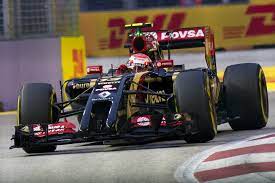As inspirational as the team's media production teams make their reveals look, the truth is: there's only one feature that matters. How fast does their cars traverse the 22-race calendar? Looking at the cars now, it's impossible to say for sure, but we do have an idea of which teams are innovating, and which aren't.
First things first:
Engines decide speed. In the turbo-hybrid era there were two kinds of teams. Those with Mercedes engines, and those without. Despite Red Bull winning 4 straight in a Renault-powered reliability nightmare, it took them to get the second best engine on the grid to have a shot in 2021. If we analyze the cars in front of us, we'll see which are hindered, and which are helped.
 |
| Aston's non-environmentally friendly green machine |
 |
| Aston's signature gills are pictured |
The car holds two major design elements. The first being the easily-noted fins on the side-pods. "Gills", or aerodynamic flaps protruding from the side-pods, are used the same way you'd expect a rear wing to operate. They create downforce across the engine cover on the car. They also add a cooling element. Interestingly, this feature only exists on the Aston and the Ferrari so far. However, there's clear reason to believe Ferrari have done theirs better. Without starting an intro to aerodynamics course, the simply explanation is that Ferrari's gills are structured to create a vortex prior to the air reaching the rear wing. This means the force of the air will hit the rear wing unobstructed.
Interestingly on the Aston however, the directionality of the airflow is less secure. It is attached to an area where air surely flows, but is often obstructed. This may be an indication of a wider Mercedes engine, but Mercedes themselves have a much tighter package. (ahem.) Speaking of which, the coke bottle exhaust is the next critical feature to a rapid 2022 F1 car.
 |
| Mercedes' incredibly slim vehicle maximizes airflow towards the rear wing. |
Given the universality of this technique, I'd venture to say any car not running it is in serious trouble. There's examples of innovation like Brawn's 2009 double diffuser, but there's more often cars like Lotus' 2014 front nosecone design. Chances are, if 8/10 kids in the class got the same answer, yours is wrong.
 |
| Lotus'... peculiar front end design |
Long story short, there are some indications the field isn't totally turning on its head next year. Haas' design is far from Ferrari's, which does indicate a one will fly, and one will fall scenario. Given the complexity of Ferrari's ideas however, and the noticeably less compact Haas vehicle, it is likely that the team in crimson comes out on top. Without knowledge of the engines or internals, it's basically impossible to guess where the cars will line up, but, without any other information. Here's a way-too-early prediction for how the field looks:
(S means the highest ranked, and each tier below that is considered less quick)
S:
Ferrari
Mercedes
A:
McLaren
B:
Aston Martin
Williams
C:
AlphaTauri
Haas
The order looks somewhat shaken up, and of course, we'll only know when we know. But if you'd like to tell your friends you know what's going to happen, this might be your only hope.

Comments
Post a Comment